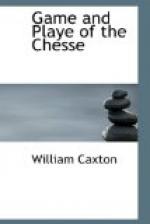Mr. Blades describes nine known copies, so that even fewer exemplars remain of the second edition than of its predecessor. The copy in the King’s Library in the British Museum is imperfect, wanting several leaves, and is mended in many places. The copy in the Pepysian Collection at Cambridge wants one-half of the last leaf. Trinity College, Cambridge, has a perfect copy, “but a bad impression.” The Bodleian copy is defective in not having the last leaf. St. John’s College, Oxford, has a copy, from which one-half of d iii. has been torn away. The Imperial Library at Vienna has an imperfect copy. The Duke of Devonshire’s copy is perfect, but it is “a poor impression, and slightly stained.” The Earl of Pembroke’s copy is very imperfect. Earl Spencer’s is only slightly imperfect. The prices fetched by the second edition have a sufficiently wide range. In 1698, at Dr. Bernard’s sale, a copy fold for 1s. 6d. Farmer’s copy in 1798 fetched L4 4s. Ratcliffe’s copy was bought at his sale for L16 by Willett; and when his books came to the hammer in 1813, it was purchased by the Duke of Devonshire for L173 5s.[7] It is interesting to know that the copy of the second edition in the Bibliotheca Spenceriana formerly belonged to Laurence Sterne, who bought it for a few shillings at York![8]
In the present reprint, the text followed is that of the first edition, transcribed from the copy in the British Museum; but the variations, alterations, and additions made in the second issue are all recorded in footnotes. The reader has, therefore, before him the work in all its fulness. The same reasons that have led to the adoption of this course have also decided the publisher to include facsimiles of the curious woodcuts which appeared in the second edition. These, although necessarily reductions in size, reproduce the quaint vigour of the originals.




